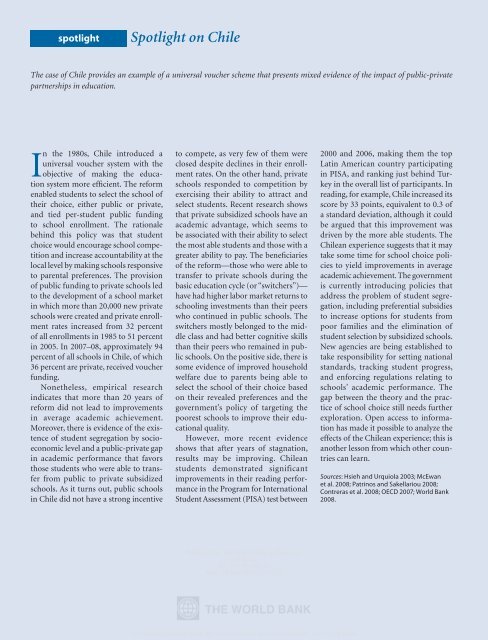The Role and Impact of Public-Private Partnerships in Education
The Role and Impact of Public-Private Partnerships in Education
The Role and Impact of Public-Private Partnerships in Education
Create successful ePaper yourself
Turn your PDF publications into a flip-book with our unique Google optimized e-Paper software.
spotlight<br />
Spotlight on Chile<br />
<strong>The</strong> case <strong>of</strong> Chile provides an example <strong>of</strong> a universal voucher scheme that presents mixed evidence <strong>of</strong> the impact <strong>of</strong> public-private<br />
partnerships <strong>in</strong> education.<br />
In the 1980s, Chile <strong>in</strong>troduced a<br />
universal voucher system with the<br />
objective <strong>of</strong> mak<strong>in</strong>g the education<br />
system more efficient. <strong>The</strong> reform<br />
enabled students to select the school <strong>of</strong><br />
their choice, either public or private,<br />
<strong>and</strong> tied per-student public fund<strong>in</strong>g<br />
to school enrollment. <strong>The</strong> rationale<br />
beh<strong>in</strong>d this policy was that student<br />
choice would encourage school competition<br />
<strong>and</strong> <strong>in</strong>crease accountability at the<br />
local level by mak<strong>in</strong>g schools responsive<br />
to parental preferences. <strong>The</strong> provision<br />
<strong>of</strong> public fund<strong>in</strong>g to private schools led<br />
to the development <strong>of</strong> a school market<br />
<strong>in</strong> which more than 20,000 new private<br />
schools were created <strong>and</strong> private enrollment<br />
rates <strong>in</strong>creased from 32 percent<br />
<strong>of</strong> all enrollments <strong>in</strong> 1985 to 51 percent<br />
<strong>in</strong> 2005. In 2007–08, approximately 94<br />
percent <strong>of</strong> all schools <strong>in</strong> Chile, <strong>of</strong> which<br />
36 percent are private, received voucher<br />
fund<strong>in</strong>g.<br />
Nonetheless, empirical research<br />
<strong>in</strong>dicates that more than 20 years <strong>of</strong><br />
reform did not lead to improvements<br />
<strong>in</strong> average academic achievement.<br />
Moreover, there is evidence <strong>of</strong> the existence<br />
<strong>of</strong> student segregation by socioeconomic<br />
level <strong>and</strong> a public-private gap<br />
<strong>in</strong> academic performance that favors<br />
those students who were able to transfer<br />
from public to private subsidized<br />
schools. As it turns out, public schools<br />
<strong>in</strong> Chile did not have a strong <strong>in</strong>centive<br />
to compete, as very few <strong>of</strong> them were<br />
closed despite decl<strong>in</strong>es <strong>in</strong> their enrollment<br />
rates. On the other h<strong>and</strong>, private<br />
schools responded to competition by<br />
exercis<strong>in</strong>g their ability to attract <strong>and</strong><br />
select students. Recent research shows<br />
that private subsidized schools have an<br />
academic advantage, which seems to<br />
be associated with their ability to select<br />
the most able students <strong>and</strong> those with a<br />
greater ability to pay. <strong>The</strong> beneficiaries<br />
<strong>of</strong> the reform—those who were able to<br />
transfer to private schools dur<strong>in</strong>g the<br />
basic education cycle (or “switchers”)—<br />
have had higher labor market returns to<br />
school<strong>in</strong>g <strong>in</strong>vestments than their peers<br />
who cont<strong>in</strong>ued <strong>in</strong> public schools. <strong>The</strong><br />
switchers mostly belonged to the middle<br />
class <strong>and</strong> had better cognitive skills<br />
than their peers who rema<strong>in</strong>ed <strong>in</strong> public<br />
schools. On the positive side, there is<br />
some evidence <strong>of</strong> improved household<br />
welfare due to parents be<strong>in</strong>g able to<br />
select the school <strong>of</strong> their choice based<br />
on their revealed preferences <strong>and</strong> the<br />
government’s policy <strong>of</strong> target<strong>in</strong>g the<br />
poorest schools to improve their educational<br />
quality.<br />
However, more recent evidence<br />
shows that after years <strong>of</strong> stagnation,<br />
results may be improv<strong>in</strong>g. Chilean<br />
students demonstrated significant<br />
improvements <strong>in</strong> their read<strong>in</strong>g performance<br />
<strong>in</strong> the Program for International<br />
Student Assessment (PISA) test between<br />
2000 <strong>and</strong> 2006, mak<strong>in</strong>g them the top<br />
Lat<strong>in</strong> American country participat<strong>in</strong>g<br />
<strong>in</strong> PISA, <strong>and</strong> rank<strong>in</strong>g just beh<strong>in</strong>d Turkey<br />
<strong>in</strong> the overall list <strong>of</strong> participants. In<br />
read<strong>in</strong>g, for example, Chile <strong>in</strong>creased its<br />
score by 33 po<strong>in</strong>ts, equivalent to 0.3 <strong>of</strong><br />
a st<strong>and</strong>ard deviation, although it could<br />
be argued that this improvement was<br />
driven by the more able students. <strong>The</strong><br />
Chilean experience suggests that it may<br />
take some time for school choice policies<br />
to yield improvements <strong>in</strong> average<br />
academic achievement. <strong>The</strong> government<br />
is currently <strong>in</strong>troduc<strong>in</strong>g policies that<br />
address the problem <strong>of</strong> student segregation,<br />
<strong>in</strong>clud<strong>in</strong>g preferential subsidies<br />
to <strong>in</strong>crease options for students from<br />
poor families <strong>and</strong> the elim<strong>in</strong>ation <strong>of</strong><br />
student selection by subsidized schools.<br />
New agencies are be<strong>in</strong>g established to<br />
take responsibility for sett<strong>in</strong>g national<br />
st<strong>and</strong>ards, track<strong>in</strong>g student progress,<br />
<strong>and</strong> enforc<strong>in</strong>g regulations relat<strong>in</strong>g to<br />
schools’ academic performance. <strong>The</strong><br />
gap between the theory <strong>and</strong> the practice<br />
<strong>of</strong> school choice still needs further<br />
exploration. Open access to <strong>in</strong>formation<br />
has made it possible to analyze the<br />
effects <strong>of</strong> the Chilean experience; this is<br />
another lesson from which other countries<br />
can learn.<br />
Sources: Hsieh <strong>and</strong> Urquiola 2003; McEwan<br />
et al. 2008; Patr<strong>in</strong>os <strong>and</strong> Sakellariou 2008;<br />
Contreras et al. 2008; OECD 2007; World Bank<br />
2008.<br />
Delivered by <strong>The</strong> World Bank e-library to:<br />
unknown<br />
IP : 192.86.100.35<br />
Mon, 30 Mar 2009 12:16:23<br />
(c) <strong>The</strong> International Bank for Reconstruction <strong>and</strong> Development / <strong>The</strong> World Bank
















